Manchester terriers are athletic, energetic, and devoted dogs. With sufficient exercise and mental stimulation, these intelligent, spirited pups make great family pets.
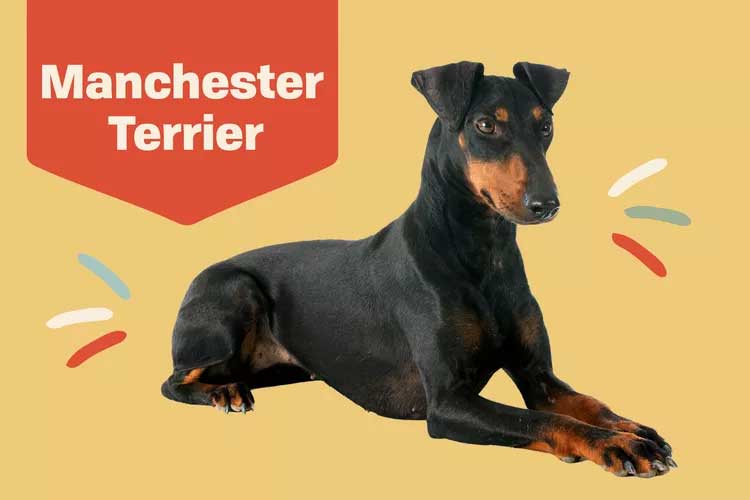
Manchester Terrier Overview
| OFFICIAL NAME | Manchester Terrier |
| COMMON NAME | Manchester Terrier |
| PET HEIGHT | 15 to 16 inches |
| PET WEIGHT | 12 to 22 pounds |
| LIFESPAN | 15 to 17 years |
| GOOD WITH | children, families |
| TEMPERAMENT | friendly, playful, willful |
| INTELLIGENCE | high |
| SHEDDING AMOUNT | infrequent |
| EXERCISE NEEDS | high |
| ENERGY LEVEL | active |
| VOCAL LEVEL | when necessary |
| DROOL AMOUNT | medium |
| BREED GROUP | terrier |
| BREED SIZE | small (0-25 lbs.) |
| COAT LENGTH | short |
| COLORS | black |
| PATTERNS | black and tan |
| OTHER TRAITS | apartment-friendly, easy to groom, good hiking companion |
You may never encounter a Manchester terrier at the dog park or the veterinarian's office: The breed, developed in the mid-1800s, almost went extinct after World War I and remains rare today. Those who know (and love) the breed appreciate the dogs' petite size—Manchester terriers are under 16 inches tall and weigh as little as 12 pounds—and their spirited personalities.
Manchester terriers were bred for hunting, but these days they are companion animals that are more likely hunting for tennis balls in the yard or comfy spots on the couch.
Though they no longer chase small prey, Manchester terriers still need an outlet for their energy. These dogs are natural athletes and smart, too, allowing them to excel in fast-paced dog sports including agility and obedience.
Expect to devote time to training—and be consistent, as Manchester terriers can be strong-willed—and provide plenty of socialization to help them feel comfortable with new people, pets, and situations. You'll be rewarded with a sweet, affectionate dog.
Appearance
It should come as no surprise that Manchester terriers were once known as "black and tan terriers." The dogs, which stand 15–16 inches tall and weigh 12–22 pounds, have black coats with tan markings. The word "sleek" is often used to describe their short coats.
Manchester terriers have naturally erect or "button" ears; small, bright, almost-black eyes; and long, tapered tails. Historically, their ears were cropped, though this practice is controversial—according to the American Veterinary Medical Association, ear cropping is often done for purely cosmetic reasons and has no health benefits for the pup.
From their arched necks and narrow chests to tucked abdomens and muscular thighs, Manchester terriers look like athletes—and move like athletes, too.
Manchester terriers look a lot like miniature pinschers, but there are some subtle differences between the two breeds. Min pins are about 5 inches shorter than Manchesters and weigh less at 8–10 pounds. Their ears are also telling: A miniature pinscher's ears are narrower than a petal-shaped Manchester's.
Temperament
Manchester terriers are "true terriers," says Michelle Barlak, co-chair of the American Manchester Terrier Club Rescue. Translation: these dogs are active, curious, and willful.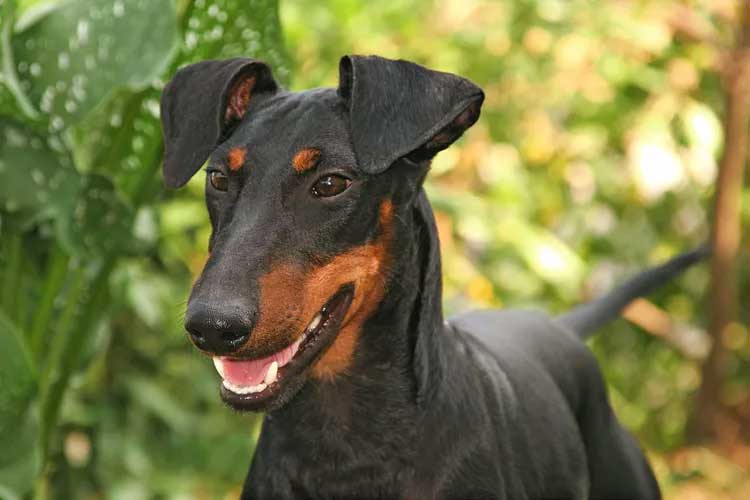
In exchange for regular exercise and consistent training, Manchester terriers provide their owners with love, companionship, and a sense of adventure. As Barlak says: "They're up for anything."
This is a breed that becomes very bonded with their owners and prefers not to be left on their own for long periods.
Despite their loving and affectionate natures at home, Manchester terriers can be slow to warm up to strangers. Barlak calls the breed "discerning," noting that early socialization can help Manchester terriers feel more comfortable in new situations.
"They don't tend to run up to strangers and fall in love with them," she says. "They want to sit back and observe for a while."
Living Needs
Providing regular opportunities to meet new people and experience new things can help Manchester terriers adapt to a range of different living situations. These terriers are good with children but will need socialization and slow introductions to other pets; due to their history as hunting dogs, the breed could see smaller animals (including the family cat) as prey.Exercise is also essential. Manchester terriers are athletic dogs that need an outlet for their energy. Go for long walks, toss tennis balls in the yard, or sign up for competitive dog sports to help your Manchester terrier burn off her energy. Without adequate exercise, Barlak warns the dogs can become bored and develop undesirable behaviors.
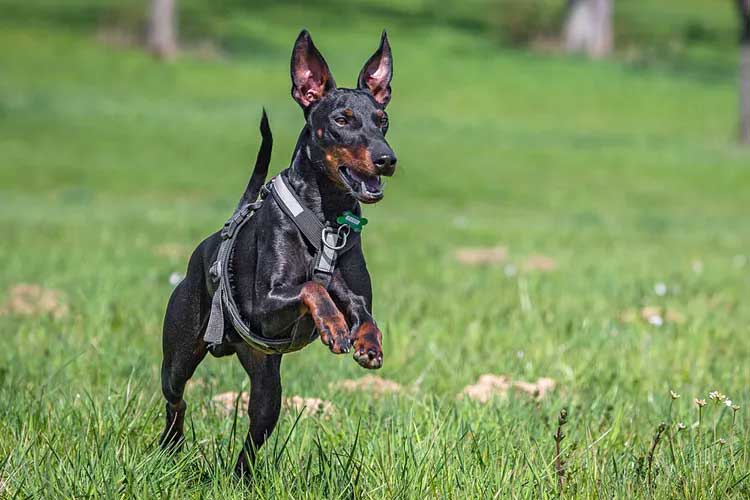
But, she says, you don't need a big yard for them to be happy. As long as their exercise needs are met, "Manchester terriers do well in all different kinds of homes and living situations, from apartments in the city to big backyards in the suburbs," Barlak says.
Care
Manchester terriers are smart and can learn basic commands quickly, but they also have willful streaks that can make them resistant to training."They are very independent thinkers," Barlak says.
Training Manchester terriers on a consistent schedule and offering lots of positive reinforcement can help them stick with training and master new skills, she adds. Because Manchester terriers are also "super smart," Barlak also advises puzzles and games that incorporate physical and mental stimulation.
These pups are active, so be prepared to be on the move. Although Manchester terrier puppies and senior dogs may only need a daily walk around the block to satisfy their exercise needs, adult dogs will need a lot more activity. They love long walks, playing at the dog park, and participating in dog sports such as rally, agility, lure coursing, and tracking.
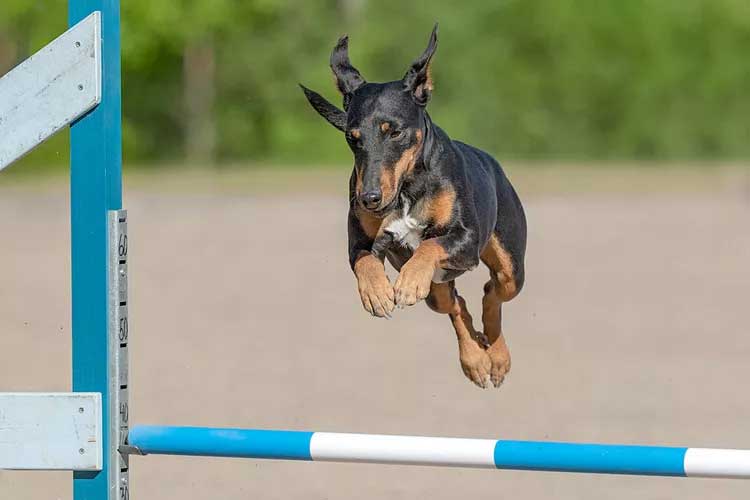
As long as a Manchester terrier gets sufficient exercise, Barlak says, she will happily settle in at home.
When it comes to grooming, Manchester terriers are low-maintenance. You'll only need to brush her once a week to remove excess hair and bathe her as needed, but her fast-growing nails will need to be trimmed weekly.
"Their nails grow very fast [and] nail injuries are painful and difficult to heal," Barlak says.
But because Manchester terriers may resist having their nails trimmed, you might want to schedule a standing appointment with a professional groomer or veterinarian who can do regular "pawdicures" to keep their nails from becoming overgrown and uncomfortable.
Health
Manchester terriers have a long lifespan of 15–17 years. And while the breed is considered fairly healthy, they can have a few common health issues, according to the American Manchester Terrier Club (AMTC).Juvenile dilated cardiomyopathy: This is a "silent" disease, meaning affected dogs often show no signs of heart disease. It's believed to be a result of a gene mutation that causes inflammation, enlargement, and dilation of the heart and mild scarring of the heart tissue. JDCM results in sudden cardiac death in dogs under 1 year old. It's more common in toy Manchester terriers but can also affect standard Manchester terriers.
Von Willebrand's Disease: This common bleeding disorder is caused by protein deficiencies that are needed for blood to clot. While many dogs with the disease show no symptoms, others experience spontaneous hemorrhaging and/or prolonged bleeding after surgeries. Genetic screening can alert you to the presence of VWD in high-risk breeds including the Manchester terrier. Your vet may want to avoid prescribing certain medications that interfere with clotting.
Xanthinuria: This condition leads to bladder of kidney stones. It's a genetic disorder that's diagnosed when too much xanthine is in the bladder, causing frequent urination, straining to pee, blood in the urine, and obstructions in the urinary tract; male dogs are more likely to develop kidney stones than females. Xanthinuria is treated with surgery. Your veterinarian may also recommend a "low purine" prescription diet to keep crystals from forming.
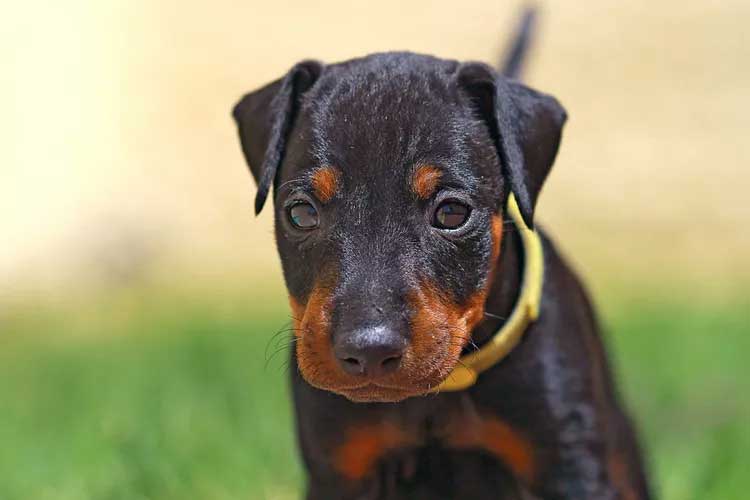
Before bringing home a Manchester terrier, your breeder should conduct all health tests recommended by the OFA. Along with the conditions above, your Manchester terrier puppy should be screened for patella luxation, deafness, and hypothyroidism.
History
Manchester terriers were bred to hunt. When the breed was developed in the 1860s, the dogs hunted rabbits and rid homes and ships of rats.As their name suggests, the Manchester terrier was developed in Manchester, England, by crossing the now-extinct Old English black and tan terrier and a whippet to create an ultra-fast hunting dog. The breed, which was quite popular in the Victorian era, was called the black and tan terrier until the 1920s.

Although the Manchester terrier has always been a small dog, it's believed that British women wanted even more diminutive companions, according to the AMTC. This led breeders to create even smaller dogs. Today, Manchester terriers come in two sizes: standard and toy Manchester terriers, which are classified as two separate breeds.
The number of Manchester terriers declined significantly after World War I. In 1946, it's believed there were only 11 purebred Manchester terriers remaining in Britain, according to the British Manchester Terrier Club. Breed enthusiasts worked to restore the breed, importing dogs from the United States to add new bloodlines and bolster the numbers.
Although the efforts helped increase the population, you're not likely to see many Manchester terriers around your neighborhood—and even fewer are available for adoption through rescue groups. It's a rare breed that Barlak believes is "vulnerable" to extinction.
Fun Facts
President Theodore Roosevelt had a Manchester terrier named Blackjack.Painter L.S. Lowry owned two Manchester terriers and often featured them in his artwork.
Queen Victoria awarded the breed a "Royal Warrant" to honor their services as royal rat catchers.